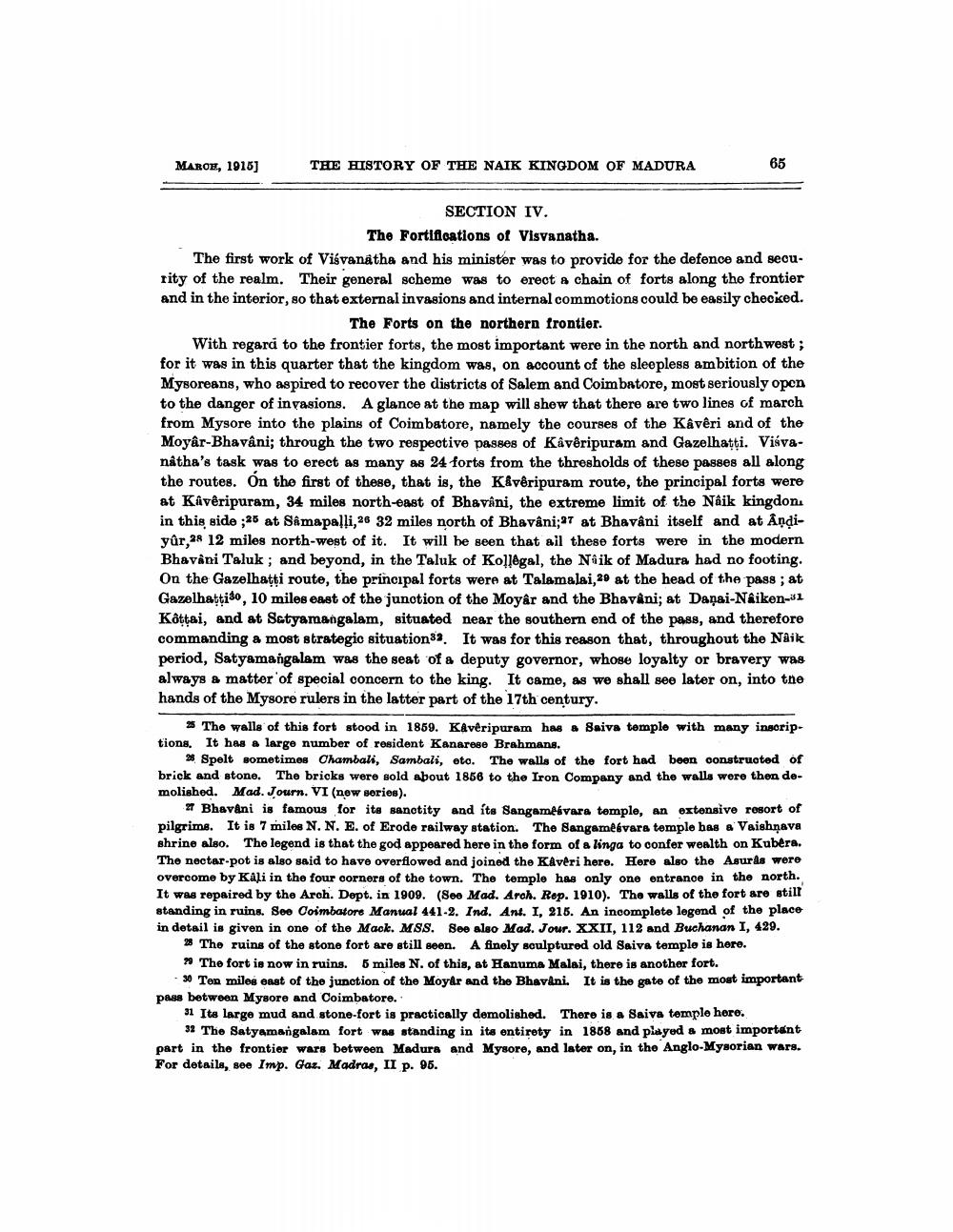________________
MAROE, 1918]
THE HISTORY OF THE NAIK KINGDOM OF MADURA
65
SECTION IV.
The Fortifications of Visvanatha. The first work of Visvanatha and his minister was to provide for the defence and secu. rity of the realm. Their general scheme was to erect a chain of forts along the frontier and in the interior, so that external invasions and internal commotions could be easily checked.
The Forts on the northern frontier. With regard to the frontier forts, the most important were in the north and northwest ; for it was in this quarter that the kingdom was, on account of the sleepless ambition of the Mysoreans, who aspired to recover the districts of Salem and Coimbatore, most seriously open to the danger of invasions. A glance at the map will show that there are two lines of march from Mysore into the plains of Coimbatore, namely the courses of the Kaveri and of the Moyâr-Bhavâni; through the two respective passes of Kaveripuram and Gazelhatti. Visvanatha's task was to erect as many as 24 forts from the thresholds of these passes all along the routes. On the first of these, that is, the K&vêripuram route, the principal forts were at Kaveripuram, 34 miles north-east of Bhavani, the extreme limit of the Naik kingdon. in this side ;25 at Samapalli, 26 32 miles north of Bhavâni;97 at Bhavani itself and at Andiyûr,28 12 miles north-west of it. It will be seen that all these forts were in the modern Bhavani Taluk; and beyond, in the Taluk of Kollégal, the Naik of Madura had no footing. On the Gazelhatti route, the principal forts were at Talamalai, 29 at the head of the pass ; at Gazelhatti30, 10 miles east of the junotion of the Moyâr and the Bhavani; at Daņai-Naiken-31 Kottai, and at Satyamangalam, situated near the southern end of the pass, and therefore commanding a most strategic situations. It was for this reason that, throughout the Naik period, Satyamangalam was the seat of a deputy governor, whose loyalty or bravery was always a matter of special concern to the king. It came, as we shall see later on, into the hands of the Mysore rulers in the latter part of the 17th century.
> The walls of this fort stood in 1859. Kåvêripuram has a Saiva temple with many inscriptions. It has a large number of resident Kanarese Brahmans.
> Spelt sometimes Chambali, Sambali, eto. The walls of the fort had been constructed of brick and stone. The bricks were sold about 1856 to the Iron Company and the walls were then demolished. Mad. Journ. VI (new series).
27 Bhavani is famous for its sanctity and its Sangamekvara temple, an extensive resort of pilgrims. It is 7 miles N. N. E. of Erode railway station. The Sangamekvara temple has a Vaishnava shrine also. The legend is that the god appeared here in the form of a linga to confer wealth on Kubera. The nectar-pot is also said to have overflowed and joined the Kaveri here. Here also the Asurds were overcome by Kali in the four corners of the town. The temple has only one entrance in the north. It was repaired by the Arch. Dept. in 1909. (See Mad. Arch. Rep. 1910). The walls of the fort are still standing in ruins. See Coimbatore Manual 441-2. Ind. Ant. I, 215. An incomplete legend of the place in detail is given in one of the Mack. MSS. See also Mad. Jour. XXII, 112 and Buchanan I, 429.
2 The ruins of the stone fort are still seen. A finely sculptured old Saiva temple is here. * The fort is now in ruins. 5 miles N. of this, at Hanuma Malai, there is another fort.
30 Ton miles east of the junction of the Moyer and the Bhavêni. It is the gate of the most important pass between Mysore and Coimbatore.
31 Its large mud and stone-fort is practically demolished. There is a Saiva temple horo.
32 The Satyamangalam fort was standing in its entirety in 1868 and played a most important part in the frontier wars between Madura and Mysore, and later on, in the Anglo-Mysorian wars. For details, see Imp. Gaz. Madras, II p. 95.




